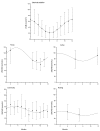Seasonal variation in the serum 25-hydroxyvitamin D levels of young and elderly active and inactive adults in São Paulo, Brazil: The São PAulo Vitamin D Evaluation Study (SPADES)
- PMID: 24494057
- PMCID: PMC3897593
- DOI: 10.4161/derm.24476
Seasonal variation in the serum 25-hydroxyvitamin D levels of young and elderly active and inactive adults in São Paulo, Brazil: The São PAulo Vitamin D Evaluation Study (SPADES)
Abstract
Objective: To evaluate the 25-hydroxyvitamin D [25(OH)D] concentrations in individuals in the city of São Paulo belonging to different age groups and exhibiting specific behavioral characteristics and to correlate the 25(OH)D concentration with the level of UV radiation (UVR).
Patients and methods: A total of 591 individuals were included, distributed as follows: 177 were living in institutions (NURSING, 76.2 ± 9.0 y old), 243 were part of the community elderly (COMMUNITY, 79.6 ± 5.3 y old), 99 were enrolled in a physical activity program targeting the elderly (ACTIVE, 67.6 ± 5.4 y old) and 72 were young (YOUNG, 23.9 ± 2.8 y old). Blood samples from all individuals were collected throughout the year. UVR measurements were taken by an official meteorology institution.
Results: The UVR values varied throughout the year, following a sinusoidal-like pattern. Because of the Earth's orbit, we hypothesized that there would be cyclic patterns for the 25(OH)D and UVR values that repeat every 12 mo. The general formula is represented by the equation P1+P2⋅sin(-2⋅π12⋅(t-P3)) The mean 25(OH)D concentration and the amplitude of the variation were significantly higher for the YOUNG and ACTIVE groups than for the COMMUNITY and NURSING groups. The nadir for UVR was in June, whereas the nadir for the 25(OH)D concentration was in the spring, corresponding to a delay of one season.
Conclusions: There was seasonal variation in the 25(OH)D concentration for all the groups studied; however, the amplitude of the variation was higher for the groups of young and physically active people, possibly due to the higher level of sunlight exposure for these groups. The lowest 25(OH)D concentration was detected in the spring.
Keywords: 25-hydroxyvitamin D; delayed response; nadir; outdoor activity; seasonal variability; sun exposure; ultraviolet radiation.
Figures



Similar articles
-
Factors affecting vitamin D status in different populations in the city of São Paulo, Brazil: the São PAulo vitamin D Evaluation Study (SPADES).BMC Endocr Disord. 2013 Apr 29;13:14. doi: 10.1186/1472-6823-13-14. BMC Endocr Disord. 2013. PMID: 23627369 Free PMC article.
-
Influence of ultraviolet radiation on the production of 25 hydroxyvitamin D in the elderly population in the city of São Paulo (23 degrees 34'S), Brazil.Osteoporos Int. 2005 Dec;16(12):1649-54. doi: 10.1007/s00198-005-1895-3. Epub 2005 Jun 10. Osteoporos Int. 2005. PMID: 15947862
-
Vitamin D deficiency and seasonal variation over the years in São Paulo, Brazil.Osteoporos Int. 2016 Dec;27(12):3449-3456. doi: 10.1007/s00198-016-3670-z. Epub 2016 Jun 23. Osteoporos Int. 2016. PMID: 27339172
-
Vitamin D status: multifactorial contribution of environment, genes and other factors in healthy Australian adults across a latitude gradient.J Steroid Biochem Mol Biol. 2013 Jul;136:300-8. doi: 10.1016/j.jsbmb.2013.01.011. Epub 2013 Feb 8. J Steroid Biochem Mol Biol. 2013. PMID: 23395985 Review.
-
Relative importance of summer sun exposure, vitamin D intake, and genes to vitamin D status in Dutch older adults: The B-PROOF study.J Steroid Biochem Mol Biol. 2016 Nov;164:168-176. doi: 10.1016/j.jsbmb.2015.08.008. Epub 2015 Aug 11. J Steroid Biochem Mol Biol. 2016. PMID: 26275945 Review.
Cited by
-
Hodgkin Lymphoma has a seasonal pattern of incidence and mortality that depends on latitude.Sci Rep. 2017 Nov 2;7(1):14903. doi: 10.1038/s41598-017-14805-y. Sci Rep. 2017. PMID: 29097683 Free PMC article.
-
Predictors of 25-hydroxyvitamin D status among individuals with metabolic syndrome: a cross-sectional study.Diabetol Metab Syndr. 2018 Jun 4;10:45. doi: 10.1186/s13098-018-0346-1. eCollection 2018. Diabetol Metab Syndr. 2018. PMID: 29928318 Free PMC article.
-
Revisiting Inflammatory Bowel Disease: Pathology, Treatments, Challenges and Emerging Therapeutics Including Drug Leads from Natural Products.J Clin Med. 2020 Apr 28;9(5):1273. doi: 10.3390/jcm9051273. J Clin Med. 2020. PMID: 32354192 Free PMC article. Review.
-
Unlocking insights: Navigating COVID-19 challenges and Emulating future pandemic Resilience strategies with strengthening natural immunity.Heliyon. 2024 Jul 17;10(15):e34691. doi: 10.1016/j.heliyon.2024.e34691. eCollection 2024 Aug 15. Heliyon. 2024. PMID: 39166024 Free PMC article. Review.
-
Does the Access to Sun Exposure Ensure Adequate Levels of 25-Hydroxyvitamin D?Rev Bras Ginecol Obstet. 2017 Mar;39(3):102-109. doi: 10.1055/s-0037-1600520. Epub 2017 Mar 15. Rev Bras Ginecol Obstet. 2017. PMID: 28297731 Free PMC article.
References
-
- Holick MF. Environmental factors that influence the cutaneous production of vitamin D. Am J Clin Nutr. 1995;61(Suppl):638S–45S. - PubMed
LinkOut - more resources
Full Text Sources
Other Literature Sources
